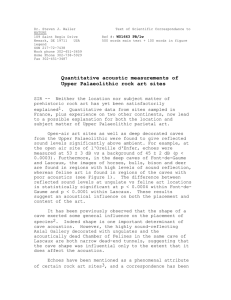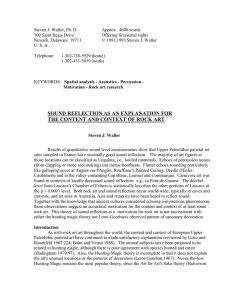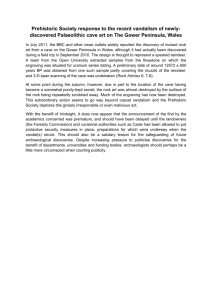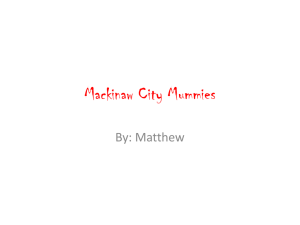Steven J. Waller, Ph. D. Approx. 4600 words
advertisement
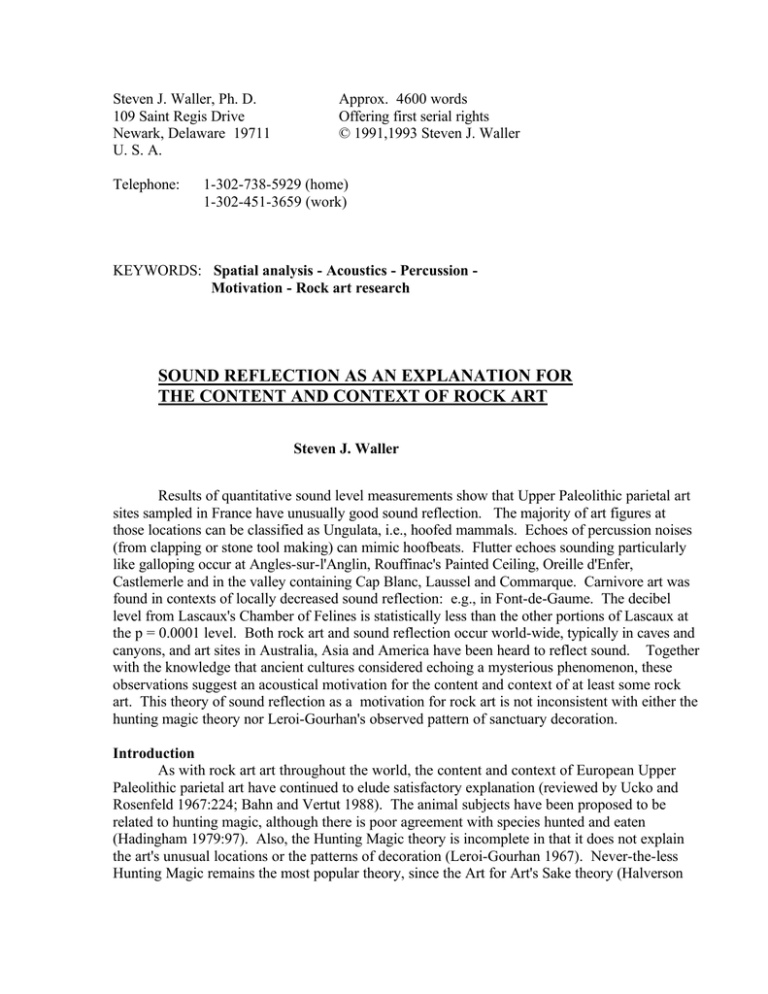
Steven J. Waller, Ph. D. 109 Saint Regis Drive Newark, Delaware 19711 U. S. A. Telephone: Approx. 4600 words Offering first serial rights © 1991,1993 Steven J. Waller 1-302-738-5929 (home) 1-302-451-3659 (work) KEYWORDS: Spatial analysis - Acoustics - Percussion Motivation - Rock art research SOUND REFLECTION AS AN EXPLANATION FOR THE CONTENT AND CONTEXT OF ROCK ART Steven J. Waller Results of quantitative sound level measurements show that Upper Paleolithic parietal art sites sampled in France have unusually good sound reflection. The majority of art figures at those locations can be classified as Ungulata, i.e., hoofed mammals. Echoes of percussion noises (from clapping or stone tool making) can mimic hoofbeats. Flutter echoes sounding particularly like galloping occur at Angles-sur-l'Anglin, Rouffinac's Painted Ceiling, Oreille d'Enfer, Castlemerle and in the valley containing Cap Blanc, Laussel and Commarque. Carnivore art was found in contexts of locally decreased sound reflection: e.g., in Font-de-Gaume. The decibel level from Lascaux's Chamber of Felines is statistically less than the other portions of Lascaux at the p = 0.0001 level. Both rock art and sound reflection occur world-wide, typically in caves and canyons, and art sites in Australia, Asia and America have been heard to reflect sound. Together with the knowledge that ancient cultures considered echoing a mysterious phenomenon, these observations suggest an acoustical motivation for the content and context of at least some rock art. This theory of sound reflection as a motivation for rock art is not inconsistent with either the hunting magic theory nor Leroi-Gourhan's observed pattern of sanctuary decoration. Introduction As with rock art art throughout the world, the content and context of European Upper Paleolithic parietal art have continued to elude satisfactory explanation (reviewed by Ucko and Rosenfeld 1967:224; Bahn and Vertut 1988). The animal subjects have been proposed to be related to hunting magic, although there is poor agreement with species hunted and eaten (Hadingham 1979:97). Also, the Hunting Magic theory is incomplete in that it does not explain the art's unusual locations or the patterns of decoration (Leroi-Gourhan 1967). Never-the-less Hunting Magic remains the most popular theory, since the Art for Art's Sake theory (Halverson WALLER SOUND & ROCK ART16Jan93 Page 2 of 12 1987) explains neither the restricted subject matter nor the unusual locations, and theories of Totism (Ucko and Rosenfeld 1967) are based on very tenuous ethnological analogies. Typically, only the visual aspects of rock art sites have been recorded. Even when acoustics are noticed, they are usually ascribed a mundane role such as enhancing music or serving as a natural amplification system. Recently, the locations of deep cave art have been suggested to correspond to places where particular musical notes resonate (Reznikoff and Dauvois 1988). While not explaining open air sites nor the art's content, that report does form part of a persistent chain of observations in the literature about acoustics and rock art. In 1957 Giedion mentioned the notion of 'acoustic space' in caverns. There have been a number of reports of 'ringing rocks' decorated with petroglyphs (Knight 1979; Hedges 1990). Certain rock art sites have been described as having echoing as a 'phenomenal attribute' (Steinbring 1992). Unfortunately, none of those reports contain quantitative acoustic measurements that can be interpreted objectively. Although those reports suggest a possible relationship between acoustics and location, there has been no theory plausibly relating acoustics to the art subject matter, leaving the motivation for the art unknown. At the mouth of a French decorated cave, the author independently became aware in 1987 of echoes, which could be perceived as sounds 'mysteriously' emanating from the cave in answer to sounds made outside. Based on this observation it was postulated that: prior to humanity's discovery of an acoustical theory of sound reflection, echoes and reverberation phenomena could have given the illusion of being spontaneously generated noises produced by certain surfaces. This would have lent a magical aura to such locations as caves and canyons that reflect sound. This postulate is supported by the fact that the ancient Greeks attributed echoes to a supernatural being, whom they named Echo (Guirand 1935). Experimentation with different types of noises was performed in a variety of acoustic environments. This led to the discovery that when rocks are struck together in the manner of making stone tools, the echoes sound remarkably like the hoofbeats of galloping horses. This was realized to be particularly relevant since statistical studies (Leroi-Gourhan 1967) of Upper Paleolithic art have shown that the most commonly depicted figures are horses, bison, mammoths, ibexes, oxen, and other herbivores. Those tabulations can be reinterpreted as showing that the vast majority of parietal European art -- greater than ninety percent -- is comprised of hoofed animals, i.e., ungulates. These consist of the orders Artiodactyla (even-toed, cloven-hoofed bovids and cervids), Perissodactyla (odd-toed horses and rhinoceroses) and Proboscida (elephants and mammoths). The observation that sound reflecting places such as caves and canyons can give rise to hoofbeat-like echoes that mimic the ungulates depicted there by prehistoric artists, provided a testable theoretical connection between the context and content of Upper Paleolithic art. Methods The hypothesis that Upper Paleolithic art is situated in locations of significant sound reflection was tested by acoustical studies of a non-random sampling of sites in the Dordogne, Lot and Vienne regions of France. These areas were selected as including representations of a wide variety of categories: open-air, shallow and deep cave art; paintings, engravings and relief sculpture; early, middle and late Upper Paleolithic periods. The study was conducted in midSpring, when sound-absorbing vegetation was intermediate in growth. Much of the open-air experimentation was performed at night for decreased background noise. The sites of Tayjat, Abri Pataud and Sainte Cirq were excluded when the results showed obvious excessive interference from modern structures. While many of the other sites have been modified also, WALLER SOUND & ROCK ART16Jan93 Page 3 of 12 either positive or negative influences on the acoustics might be expected. The placement of the art and the geometry of each site was noted while the acoustics were characterized by sound reflectance experimentation at defined locations. This technique consisted of producing a single loud percussion noise via each of the following in turn: striking rocks, clapping hands, yelling in a sharp vocal burst, and using a spring-loaded device designed to deliver a percussive sound with a reproducible intensity at a level comparable to natural clapping. After the generation of each single sound, the direction was noted from which the resulting reflected sound was heard, and subjectively judged for sound reflection characteristics. For quantitation, the experiments were recorded on high bias chromium dioxide tape using a PMD420 Maranz cassette recorder having Dolby noise reduction and equipped with a Dynamic LOZ Shure SM57 omni-directional microphone, which was placed 1 m from the original sound source. The recordings with the tests using the spring-loaded reproducible device were measured for reflected sound using a Brüel and Kjær model 2232 precision sound level meter (settings: SLOW, 34-94 dB, AUTO) calibrated with a Brüel and Kjær model 4230 sound level calibrator to 93.8 decibels (A) at 1000 Hz. Playback of the recordings was through an auditorium sound system on a Technics model RS-M6 with Dolby noise reduction and a pause feature that was used to stop the tape immediately after the primary percussive burst. When the sound level meter had quieted, tape play was resumed to measure reflected sound, which was compared to the recorded background ambient noise of the art site. The dB values reported are relative in that the measured intensity of echoing heard at a given location is a function of the loudness of the primary sound made, the efficiency of the recording apparatus, the playback volume, and geometry of the sound level meter in relation to the speakers; for these reasons the sound level measurements were all made under the same conditions. Results The results of quantitative sound level measurements are presented in Figure 1, showing that Paleolithic art sites are commonly associated with statistically significant sound reflection, at levels easily discernable to the human ear. More detailed quantitative analyses are being reported elsewhere. Subjective descriptions of acoustics at the various sites tested are summarized below. (A) Open Air Sites. Numerous art sites were found to produce sound reflection in the form of multiple distinct percussive echoes reminiscent of galloping hoofed animals. At the Abri du Roc aux Sorciers, Angles-sur-L'Anglin, one can clearly hear an echo originating from the sloping hill across the stream. When one is standing across the stream on that slope, a series of two to three strong echoes appears to emanate from the exact location of the ungulate sculptures in the rock shelter near the base of the cliff. The powerful echo intensity from that place is due to the wave-focusing effect of both the shelter and the concave shape of the surrounding cliff face itself. The entire Vallon des Roches, containing the several rock art sites of Castelmerle (Sergeac), produces loud multiple echoes at diverse locations, including the Riverdit shelter. When questioned, the guides confirmed that, especially in the winter when there is an absence of leaves, echoes are indeed clearly heard during demonstrations of stone tool-making techniques. In La Vallée de la Grande Beune, with Cap Blanc, Commarque and Laussel, one can hear distinct echoes throughout the valley coming in a series from the various mountain sides, giving the impression that the source of the sound moves. Cap Blanc is especially celebrated for its life-sized bas reliefs of horses and bison. Notably, at Cap Blanc the source of the strongest echo is Commarque. WALLER SOUND & ROCK ART16Jan93 Page 4 of 12 At Oreille d'Enfer, one hears an echo coming from a facing cliff. At that facing cliff, which is at the head of the valley of Gorge d'Enfer, the clearly visible location where the sculptures of hoofed animals were removed from Oreille d'Enfer is the source of a strong echo. Also at that cliff, many other echoes sounding very much like galloping can be heard to come from unseen locations in the direction of the foot of the valley. Although Abri Poisson with its relief of a salmon is walled off, the adjacent small rock shelter (thought to be similar to what Abri Poisson was naturally like in Paleolithic times) gives a single, sharp, high-pitched echo. This can indeed be interpreted as sounding like a fish slapping on the water's surface after jumping into the air, as salmon commonly do. At Largerie Haute, Largerie Basse, Le Roc Sainte Christopher, and outside BaraBahau, one hears faint but clear and numerous echoes that appear to originate in multiple locations in the distance. La Madeleine is a very interesting place to hear sound reflection since there is a long series of echoes that appears to be generated from all up and down the river. The small canyons outside of Font-de-Gaume, La Mouthe, and Les Combarelles/Grotte Rey all produce clear multiple echoes. These can be heard either at the entrances to the caves, or at positions across the canyons, in which case the echoes appear to emanate from the mouths of these caves, all of which contain a large amount of ungulate art. (B) Deep caves. Inside most caves, sound reflects from the surrounding walls in such a manner as to give the effect of reverberation, rather than being manifest as distinct echoes. The texture of the wall surfaces together with the geometry of the cave determine the intensity, duration, and apparent location of the source of the reverberation. As with open-air art, it was found in general that the majority of cave art correlates with locations of optimum acoustics. An important exception was found to the correlation of art and good acoustics: carnivores were observed to be associated with the disappearance of sound reflection in the interior of caves. Font-de-Gaume has fair acoustics in the passageway near the entrance, where there are traces of poorly preserved paintings. The sound intensity increases dramatically beyond the Rubicon constriction that marks the beginning of the first major art gallery. The main galleries, Grande Carrefour, lateral gallery, and Cabinet des Bisons -- i.e., the locations where the images of large ungulates are concentrated -- all give the strongest and longest duration vibrations within the cave. Within the main galleries the acoustics are uniform and symmetrical, and here are found occurrences of symmetrical art such as the friezes of facing bison. The terminal fissure contains a feline, and sound level measurements of this location demonstrate a statistically significant (p < 0.0004) decrease in sound reflection vs the portions of the cave having ungulate art. There is a bear at the very end of the lateral gallery, which was experienced as having relatively dampened acoustics, but the dB level difference was not statistically significant. In the Chamber of Bulls at Lascaux, one is surrounded by deep, long-lasting sound coming from all directions, consistent with the evenly spaced and balanced composition of the large bulls. The comparably decorated Axial gallery has equally wonderful acoustics. The sound in the Apse, with its intricate engravings, is also excellent (the adjoining Pit was hermetically sealed off at the time of the experiment and it is predicted that the sound is even better when the entrance to the Pit is open). At the location of the two back-to-back mirror-image bison in the Nave, sounds are stereophonically identical in each direction. In extreme contrast to these excellent acoustics, upon entering the Chamber of Felines there is a sudden, almost complete lack of sound reflection, due to the wave absorbing property of its soft clay walls. The difference in sound levels at ungulate vs feline art locations within Lascaux is statistically significant at p < 0.0001. WALLER SOUND & ROCK ART16Jan93 Page 5 of 12 In Les Combarelles, the corridor between the entrance and the start of the engravings has extremely poor acoustics. Deeper in the acoustics improve, and at 'homme-mammothe No. 4' (man-mammoth) there begins a noticeable vibration bouncing back and some faint flutter echoing. Located in a hollow that amplifies sound is an engraving of a human in the position of clapping hands. The reverberation is most intense in the front, middle and inner galleries, with their rightangled corridors serving to reflect sound well; it is here that is found the greatest concentration of engravings, consisting primarily of large hoofed animals. After having improved from the entrance to the main galleries, the acoustics then only gradually decrease until sound reflection is quite poor at the terminal tunnel; several carnivores are scattered near this end. The engravings in Les Combarelles II are located in a high chamber that has superior sound reflection relative to the rest of the dirt-walled cave. Upon entering Bernifal, reflected sound appears to come from deep within the cave. In the second chamber where the ungulate art is concentrated, the vibrations are superb. In the farthest large chamber, sound of great intensity also emanates from a side tunnel containing mammoth drawings; when I positioned myself at the location from which to best hear the sound reflecting out of that tunnel, the guide then pointed out that I was at the exact location of the cave's important complex tectiform. The narrow end of the farthest chamber, where a bear is depicted, appeared to have a diminished quality of sound reflection compared to the rest of the cave (but the dB level turned out not to be statistically significant). Just inside Bara-Bahau, sound reflects from deep within the cave and emanates from the far end of the original access passageway that leads to the chamber with the engravings. The engraved chamber itself has good acoustics. The numerous concavities along the corridor of La Mouthe make for excellent sound amplification. The majority of the art, which includes mammoths and bison, is located in these reverberating chambers. The 'hut' engraving is in one of the largest of these, and at the entrance to its chamber sound appears to come from the wall where the hut is painted. Throughout Pech-Merle, the acoustics are superb but elusive. From any point within the cave, sound always appears to come back from various other locations of the complex cavern, and the apparent sources are difficult to localize. Correspondingly, the art is also evenly dispersed in groupings throughout (except for the chamber with the foot impression). The mirror-image symmetry of the centrally-located spotted horses agrees well with the uniform sound reflections. The cave of Cougnac in Lot is a particularly clear example of the association of art location and acoustics. In the large cavern and passageways near the entrance where there is no art, the acoustics are unexceptional. The sound appears to always come from farther back in the cave, and the quality of sound reflection improves as one travels away from the entrance. Near the passageway to the final chamber, and at the mouth of a small tunnel leading to that chamber, tectiforms appear at locations especially suitable for hearing good sound effects coming from deeper within. The final chamber itself has magnificent, very profound reverberations of unusually long duration. At the entrance to this final chamber, one can see the paintings of hoofed animals on the facing concave wall, which is the precise location from which the sound appears to originate. Also, when one is at other locations within this final chamber, e.g., at the small symbols directly opposite the painted walls, the sound still seems to emanate from where the animals are painted. The sound effects are optimum at the paintings themselves. At the great ibex, intense sound reflection occurs due to the adjacent opening to a low tunnel in which mammoths are represented. WALLER SOUND & ROCK ART16Jan93 Page 6 of 12 In Rouffignac's Grotte des Cents Mammouthes, there are numerous instances of 'confronting' (mirror-image facing) mammoths, and at each case that was studied, stereophonically symmetrical sound reflection was observed down the corridor in each direction. The Painted Ceiling, with its concentration of mammoths, horses, ibexes and other ungulates, stands out as the most impressive acoustic location within the cave. The ceiling itself 'buzzes' with a flutter echo. (The effect is easiest to hear with fewer sound-absorbing bodies present.) The unusually good sound reflection at this spot is probably due to the deep pit located in that chamber directly underneath the stone ceiling. Discussion The observed data support the hypothesis that the majority of both open-air and deep cave Paleolithic parietal art is associated with locations of good sound reflection, perceived as either distinct echoes or reverberation. The correlation of art and acoustics suggests that a given rock face was selected not merely for its suitability as an art surface, but because of its property of reflecting sound. This property is due to a complex combination of the difference in density between rock and air, the shape of the rock surface, the spatial geometry of the general location, and the position of the sound source and listener. A particular abundance of echoes was observed from the cliffs and exposed rock surfaces common in the regions of Dordogne and Lot, which were included in the study area partially because of the convenience afforded by their concentration of art sites. It is concluded that it would have been impossible for a society to occupy these regions without hearing echoes. Modern humans, who understand sound reflection, tend to trivialize echoes, and this may be the reason that the motivation for rock art has remained so long an enigma. Since the theoretical physics of acoustics was not fully explained until modern times, it is highly improbable that Paleolithic humans comprehended the nature of sound reflection. It is most likely that they had a mythical pseudo-explanation for echoes, as did the ancient Greeks who believed that these sounds were produced by a spirit named Echo. Ancient peoples in the South Pacific are known to have revered sound reflection since they believed that 'echo, as the bodiless voice, is the earliest of all existence' (Jobes 1961). Such a mysterious phenomenon as sounds appearing to emanate spontaneously from solid rock would serve as a basis for considering sound reflecting locations as sacred, thus providing an explanation of the motivation for selecting locations for art. Any theory for the motivation of Paleolithic art must explain not only the locations of the art, but also the content of the art. The discovery that echoes of percussive noises resemble to a remarkable degree the sounds of galloping hoofed animals provides a crucial link between the context and the content of the art. Admittedly, the interpretation of percussive echoes as hoofbeats is the author's subjective opinion. (Manuscripts are in preparation comparing objective audio signals of real hoofbeats with echoes of percussions at art sites.) Readers are encouraged to form their own opinions by clapping at echoing locations (e.g., standing 20 to 40 m from a flat, solid surface, or between two facing buildings). A logical argument follows, for the hearing impaired: Paleolithic tool-making industry was based on striking rocks together in a manner that results in loud percussive sounds, or bursts of air vibration energy. By reflecting off hard surfaces echoes simply repeat such sounds, resulting in additional percussion sounds not made by humans, and which appear to originate from the reflecting surfaces as do light images in a mirror. A variety of simple percussion devices are used by orchestras today to easily mimic the clip-clop of horse hooves striking the ground. WALLER SOUND & ROCK ART16Jan93 Page 7 of 12 Without an understanding of sound reflection, Cro-Magnon must have been greatly mystified upon hearing -- only in certain special locations -- hoofbeat-like percussion sounds, yet being unable to see animals making the sounds. This would have meant that the hoofbeats were apparently produced by animals that were invisible, therefore supernatural. Equally inexplicable and even louder sound reflection in the form of reverberation also appears to have been associated with animals by the cave artists. The term reverberation refers to a series of sound reflections so closely spaced that the echoes are not distinguishable as separate sounds. In a stampede, individual hoofbeats cannot be distinguished, so that the thundering sound made by the hooves of herds of ungulates is similar to the reverberation of a cave. The proposed theory that Upper Paleolithic humans of France attributed percussive sound reflection to hoofed animals is consistent with that culture's art containing predominantly hoofed animals, and correlating with locations of optimal acoustics. The recognition that certain frequently occurring signs actually represent hoofprints (Delluc 1985) emphasizes the importance of hooves. Furthermore, 'What is not in doubt is the ever increasing preoccupation with representing movement during the course of the evolution of Upper Paleolithic art.' (LeroiGourhan 1981:42). Based on the observations reported herein, it is proposed that the artists were attempting to express not only the sight, but also the sounds, of moving hoofed animals. The placement of carnivore art in locations of greatly diminished acoustics is consistent with, rather than an exception to, this theory of sound reflection. It is concluded that a decrease in sound reflection, rather than merely a dead-end shape, is associated with the placement of felines, since dead-end tunnels similar in shape to Lascaux's Chamber of Felines or Font-deGaume's Terminal Fissure, but which have good acoustics (e.g., Lascaux's Axial gallery, and Bernifal's mammoth tunnel) are decorated with ungulates instead of carnivores. The silence could have been interpreted as stealthy cats. Alternatively, carnivores may have been the artists' explanation for the disappearance of the sound reflections that were associated with hoofed animals (such places are even today thought of as being acoustically 'dead'). The undeniable, reproducible, and demonstrable presence of an inexplicable phenomenon would be conducive to an enduring societal belief, and is consistent with a tradition that lasted 20 000 years. The abrupt cessation of art at the end of the Upper Paleolithic after twenty millennia must be accounted for, as well as its existence. In the theory being proposed, the art was motivated by the misperception of echoing percussions as being spontaneously produced supernatural hoofbeats. Once the phenomenon was more correctly perceived as simply a natural form of sound repetition (not necessarily requiring a full understanding of acoustics), the motivation for the art would have been immediately and completely dispelled. (Could vestiges of the resulting concept that the ungulate cave art tradition was wrong have survived in the form of ancient customs that associate evil with the underworld, graven images, and the hoof?) While this is but a preliminary report of observations in a relatively small area, the results of sound reflection experimentation on other continents are suggestive of the broad applicability of the new acoustical methodology described, since both rock art and sound reflection exist globally. (Manuscripts are in preparation describing echoing rock art sites in Pennsylvania, Wyoming, Arizona and Utah of North America, and in the Laura region of Queensland, Australia). Regional variations would be expected in the interpretation of various sound reflections, e.g., by peoples not in contact with ungulates, thus possibly explaining regional variation in rock art content. In addition to being employed in spatial analysis for characterizing known rock art, a potential practical application of the described technique of sound reflectance is in searches to locate undiscovered art. During acoustical investigations of several sites, the author 'discovered' WALLER SOUND & ROCK ART16Jan93 Page 8 of 12 rock art locations (unknown to me but actually previously documented) by examining rock surfaces that were the apparent sources of echoes. Confirmation that sound reflection is the raison d'être of some of the world's oldest art would mean that any modification affecting the acoustical properties of those art sites, such as passageway enlargements for easy access to tourists, or walls meant to protect the graphic content of the art, should be avoided. Conservation of the acoustical context of prehistoric art is urgently recommended to avoid irreversibly threatening efforts to reconstruct the beliefs of early humanity. Acknowledgements Appreciation is extended to those graciously allowing access to the art sites, guiding tours and engaging in helpful discussions: M. Archambeau, J-P. Chadelle, J. Clottes, Mme Daubisse and sister, Mme Duret, P. Foucher, J. Francis, M. Lorblanchet, J-C. Papinot, Y. Pemandrant, J. Plassard and father, and J-Ph. Rigaud. I thank A. Graham IV and L. Duggan for valuable assistance with preliminary aspects of this work; I also gratefully acknowledge my wife Patrice and son Jason for their continual support throughout this project. REFERENCES BAHN, P. G. and VERTUT, J. 1988. Images of the Ice Age. Facts New York. on File, DAUVOIS, M. 1989. Sons et musique paléolithiques. Les l'Archéologie 142: 2-11. Dossiers de Giedion, S. 1957. The Eternal Present: The Beginnings of Art. New York, p. 526. Pantheon, GUIRAND, F. 1935. Greek Mythology. Translated by Delano Hamlyn Limited, London (pp 122, 127). Ames. Paul HADINGHAM, E. 1979. Secrets of the Ice Age. Walker and Co., New York (p 97). HALVERSON, J. 1987. Art for art's sake in the Paleolithic. Anthropology 28:63-89. Current JOBES, G. 1961. Dictionary of Mythology, Foklore and Symbols. Scarecrow Press, Inc., New York (pp 490, 785). LEROI-GOURHAN, A. 1967. Treasures of Prehistoric Art. N. Guterman. Abrams, New York. Translated by LEROI-GOURHAN, A. 1981. The Dawn of European Art. S. Champion. Cambridge University Press, Cambridge (p 42). Translated by WALLER SOUND & ROCK ART16Jan93 Page 9 of 12 REZNIKOFF, I. and M. DAUVOIS 1988. La dimension sonore des grottes ornées. Bulletin de la Société Préhistorique Française 85: 238-246. UCKO, P. J. and A. ROSENFELD 1967. Paleolithic Cave Art. New York. McGraw-Hill, FIGURE 1. Sound Reflection Levels at Paleolithic Art Sites in France. Relative sound level is expressed on the value axis as decibels above ambient background noise. Abbreviations of sites stand for, respectively: Control (a lightly wooded area with no art near Les Eyzies); Abri du Roc aux Sorciers in Angles-sur-l'Anglin, with ungulate art; Oreille d'Enfer, with ungulate art; Font-de-Gaume's ungulate locations; Font-de-Gaume's terminal fissure with feline; Lascaux's ungulate locations; Lascaux's Chamber of Felines; WALLER SOUND & ROCK ART16Jan93 Page 10 of 12 Bernifal's ungulate art locations; Cougnac's ungulate art locations; Rouffignac's Grotte des Cents Mammouthes's ungulate art locations.
